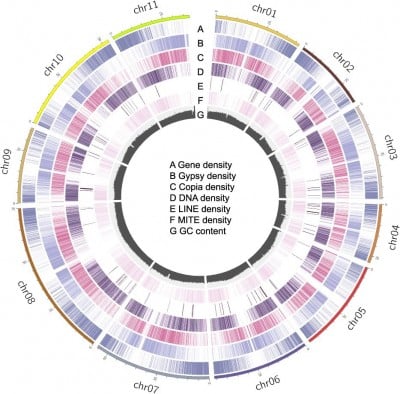Science
Researchers Unveil First Gap-Free Mung Bean Genome for Breeding Advances

A team of researchers has achieved a significant milestone by generating the first **telomere-to-telomere (T2T)**, gap-free genome of the **mung bean** (*Vigna radiata*). This groundbreaking study, employing advanced sequencing technologies from **PacBio**, **Oxford Nanopore**, and **Hi-C**, provides crucial insights into the genetic variations that have influenced the plant’s domestication and adaptation.
The research, published recently, highlights how structural variations within the mung bean genome have played a vital role in its evolution. By identifying key genetic changes associated with plant architecture, stress response, and metabolic pathways, the study paves the way for enhanced understanding and potential advancements in mung bean cultivation.
Understanding Genetic Changes and Their Implications
The researchers focused on the amplification of transposable elements, which significantly reshaped the expression of nearby genes. Notably, genes involved in **fatty acid synthesis**, **suberin formation**, and **phenylpropanoid metabolism** were found to have undergone strong selection pressures throughout the plant’s evolution. These findings underscore the complexities of genetic adaptations that have allowed the mung bean to thrive in diverse environments.
The comprehensive genome created through this study serves as a valuable resource for both scientists and agricultural practitioners. It lays the groundwork for molecular breeding efforts aimed at enhancing the yield and resilience of mung bean crops. The insights gained from this research could lead to the development of improved varieties that are better suited to changing climate conditions and agricultural challenges.
Future Directions in Mung Bean Research
With the completion of this genome, researchers are now better equipped to explore the genetic underpinnings of traits critical for mung bean cultivation. The study emphasizes the importance of integrating advanced sequencing technologies to gain a more complete picture of plant genetics. As the demand for sustainable agricultural practices grows, this research could play a pivotal role in developing new strategies for crop improvement.
In conclusion, the successful mapping of the mung bean genome represents a significant leap forward in plant science. It not only sheds light on the evolutionary history of this important legume but also opens new avenues for breeding initiatives that aim to improve food security and agricultural sustainability worldwide.
-

 Lifestyle3 months ago
Lifestyle3 months agoLibraries Challenge Rising E-Book Costs Amid Growing Demand
-

 Sports3 months ago
Sports3 months agoTyreek Hill Responds to Tua Tagovailoa’s Comments on Team Dynamics
-

 Sports3 months ago
Sports3 months agoLiverpool Secures Agreement to Sign Young Striker Will Wright
-

 Lifestyle3 months ago
Lifestyle3 months agoSave Your Split Tomatoes: Expert Tips for Gardeners
-

 Lifestyle3 months ago
Lifestyle3 months agoPrincess Beatrice’s Daughter Athena Joins Siblings at London Parade
-

 World3 months ago
World3 months agoWinter Storms Lash New South Wales with Snow, Flood Risks
-

 Science3 months ago
Science3 months agoTrump Administration Moves to Repeal Key Climate Regulation
-

 Business3 months ago
Business3 months agoSoFi Technologies Shares Slip 2% Following Insider Stock Sale
-

 Science2 months ago
Science2 months agoSan Francisco Hosts Unique Contest to Identify “Performative Males”
-

 Science3 months ago
Science3 months agoNew Tool Reveals Link Between Horse Coat Condition and Parasites
-

 Sports3 months ago
Sports3 months agoElon Musk Sculpture Travels From Utah to Yosemite National Park
-

 Science3 months ago
Science3 months agoNew Study Confirms Humans Transported Stonehenge Bluestones









